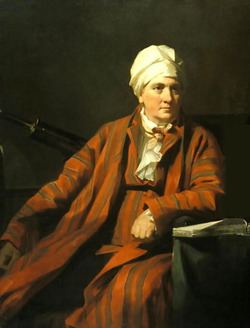Citizenship Great Britain Role Physicist Name John Robison | Alma mater Glasgow University Nationality Scottish | |
 | ||
Institutions Glasgow University, Edinburgh University Died January 30, 1805, Edinburgh, United Kingdom Books Proofs of a Conspiracy, Proofs of a Conspiracy Against A, Proofs of a Conspiracy: Against A, Proofs of a Conspiracy: Against A, Proofs of a Conspiracy Against A | ||
John Robison FRSE (4 February 1739 – 30 January 1805) was a Scottish physicist and mathematician. He was a professor of philosophy at the University of Edinburgh.
Contents
- The physicist
- The conspiracy theorist
- Works
- Proofs of Conspiracy reprints and related documents
- References

A member of the Edinburgh Philosophical Society when it received its royal warrant, he was appointed as the first general secretary to the Royal Society of Edinburgh (1783–98). Robison invented the siren and also worked with James Watt on an early steam car. Following the French Revolution, Robison became disenchanted with elements of the Enlightenment. He authored Proofs of a Conspiracy in 1797—a polemic accusing Freemasonry of being infiltrated by Weishaupt's Order of the Illuminati.
His son was the inventor Sir John Robison (1778–1843).
The physicist
The son of John Robison, a Glasgow merchant, he was born in Boghall, Baldernock, Stirlingshire (now East Dunbartonshire) and attended Glasgow Grammar School and the University of Glasgow (MA 1756). After a brief stay in London in 1758 Robison became the tutor to the midshipman son of Admiral Knowles, sailing with the Royal Navy on General Wolfe's expedition to Quebec and Portugal (1756–62). His mathematical skills were employed in navigation and surveying. Returning to England in 1762, he joined the Board of Longitude — a team of scientists who tested John Harrison’s marine chronometer on a voyage to Jamaica.
On his return he settled in Glasgow engaging in the practical science of James Watt and Joseph Black in opposition to the systematic continental European chemistry of Antoine Lavoisier and its adherents such as Joseph Priestley. In 1766 he succeeded Black as Professor of Chemistry at the University of Glasgow. He in turn was succeeded in 1770 by Black's assistant, William Irvine.
In 1769, he announced that balls with like electrical charges repel each other with a force that varies as the inverse-squared of the distance between them, anticipating Coulomb's law of 1785.
In 1770 he travelled to Saint Petersburg as the secretary of Admiral Charles Knowles, where he taught mathematics to the cadets at the Naval Academy at Cronstadt, obtaining a double salary and the rank of lieutenant colonel.
Robison returned to Scotland in 1773 and took up the post of Professor of Natural Philosophy at the University of Edinburgh. He lectured on mechanics, hydrostatics, astronomy, optics, electricity and magnetism. His conception of mechanical philosophy’ became influential in nineteenth-century British physics. His name appears in the 1776 "Minute Book of The Poker Club", a crucible of the Scottish Enlightenment. In 1783 he became General Secretary of the Royal Society of Edinburgh and in 1797 his articles for the Encyclopædia Britannica gave a good account of the scientific, mathematical and technological knowledge of the day. He also prepared for publication, in 1799, the chemical lectures of his friend and mentor, Joseph Black.
Robison worked with James Watt on an early steam car. This project came to nothing and has no direct connection to Watt's later improvement of the Newcomen steam engine. He along with Joseph Black and others gave evidence about Watt's originality and their own lack of connection to his key idea of the Separate Condenser.
Robison did however invent the siren, though it was Charles Cagniard de la Tour who named it after producing an improved model.
The conspiracy theorist
Towards the end of his life, he became an enthusiastic conspiracy theorist, publishing Proofs of a Conspiracy ... in 1797, alleging clandestine intrigue by the Illuminati and Freemasons (the work's full title was Proofs of a Conspiracy against all the Religions and Governments of Europe, carried on in the secret meetings of Freemasons, Illuminati and Reading Societies). The secret agent monk, Alexander Horn provided much of the material for Robison's allegations. French priest Abbé Barruel independently developed similar views that the Illuminati had infiltrated Continental Freemasonry, leading to the excesses of the French Revolution. In 1798, the Reverend G. W. Snyder sent Robison's book to George Washington for his thoughts on the subject in which he replied to him in a letter:
It was not my intention to doubt that, the Doctrines of the Illuminati, and principles of Jacobinism had not spread in the United States. On the contrary, no one is more truly satisfied of this fact than I am. The idea that I meant to convey, was, that I did not believe that the Lodges of Free Masons in this Country had, as Societies, endeavoured to propagate the diabolical tenets of the first, or pernicious principles of the latter (if they are susceptible of separation). That Individuals of them may have done it, or that the founder, or instrument employed to found, the Democratic Societies in the United States, may have had these objects; and actually had a separation of the People from their Government in view, is too evident to be questioned.
Modern conspiracy theorists, such as Nesta Webster and William Guy Carr, believe the methods of the Illuminati as described in Proofs of a Conspiracy were copied by radical groups throughout the 19th and 20th centuries in their subversion of benign organizations. Spiritual Counterfeits Project editor Tal Brooke has compared the views of Proofs of a Conspiracy with those found in Carroll Quigley's Tragedy and Hope (Macmillan, 1966). Brooke suggests that the New World Order, which Robison believed Adam Weishaupt (founder of the Illuminati) had in part accomplished through the infiltration of Freemasonry, will now be completed by those holding sway over the international banking system (e.g., by means of the Rothschilds' banks, the U.S. Federal Reserve, the International Monetary Fund, and the World Bank).
